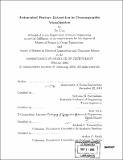| dc.contributor.advisor | Nicholas M. Patrikalakis and Seth Teller. | en_US |
| dc.contributor.author | Guo, Da, 1976- | en_US |
| dc.contributor.other | Massachusetts Institute of Technology. Dept. of Electrical Engineering and Computer Science. | en_US |
| dc.date.accessioned | 2006-07-13T15:24:23Z | |
| dc.date.available | 2006-07-13T15:24:23Z | |
| dc.date.copyright | 2004 | en_US |
| dc.date.issued | 2004 | en_US |
| dc.identifier.uri | http://hdl.handle.net/1721.1/33438 | |
| dc.description | Thesis (S.M.)--Massachusetts Institute of Technology, Dept. of Ocean Engineering; and, (S.M.)--Massachusetts Institute of Technology, Dept. of Electrical Engineering and Computer Science, 2004. | en_US |
| dc.description | Includes bibliographical references (leaves 141-147). | en_US |
| dc.description.abstract | The ocean is characterized by a multitude of powerful, sporadic biophysical dynamical events; scientific research has reached the stage that their interpretation and prediction is now becoming possible. Ocean prediction, analogous to atmospheric weather prediction but combining biological, chemical and physical features is able to help us understand the complex coupled physics, biology and acoustics of the ocean. Applications of the prediction of the ocean environment include exploitation and management of marine resources, pollution control such as planning of maritime and naval operations. Given the vastness of ocean, it is essential for effective ocean prediction to employ adaptive sampling to best utilize the available sensor resources in order to minimize the forecast error. It is important to concentrate measurements to the regions where one can witness features of physical or biological significance in progress. Thus automated feature extraction in oceanographic visualization can facilitate adaptive sampling by presenting the physically relevant features directly to the operation planners. Moreover it could be used to help automate adaptive sampling. Vortices (eddies and gyres) and upwelling, two typical and important features of the ocean, are studied. | en_US |
| dc.description.abstract | (cont.) A variety of feature extraction methods are presented, and those more pertinent to this study are implemented, including derived field generation and attribute set extraction. Detection results are evaluated in terms of accuracy, computational efficiency, clarity and usability. Vortices, a very important flow feature is the primary focus of this study. Several point-based and set-based vortex detection methods are reviewed. A set-based vortex core detection method based on geometric properties of vortices is applied to both classical vortex models and real ocean models. The direction spanning property, which is a geometric property, guides the detection of all the vortex core candidates, and the conjugate pair eigenvalue method is responsible for filtering out the false positives from the candidate set. Results show the new method to be analytically accurate and practically feasible, and superior to traditional point-based vortex detection methods. Detection methods of streamlines are also discussed. Using the novel cross method or the winding angle method, closed streamlines around vortex cores can be detected. | en_US |
| dc.description.abstract | (cont.) Therefore, the whole vortex area, i.e., the combination of vortex core and surrounding streamlines, is detected. Accuracy and feasibility are achieved through automated vortex detection requiring no human inspection. The detection of another ocean feature, upwelling, is also discussed. | en_US |
| dc.description.statementofresponsibility | by Da Guo. | en_US |
| dc.format.extent | 147 leaves | en_US |
| dc.format.extent | 6095790 bytes | |
| dc.format.extent | 6101974 bytes | |
| dc.format.mimetype | application/pdf | |
| dc.format.mimetype | application/pdf | |
| dc.language.iso | eng | en_US |
| dc.publisher | Massachusetts Institute of Technology | en_US |
| dc.rights | M.I.T. theses are protected by copyright. They may be viewed from this source for any purpose, but reproduction or distribution in any format is prohibited without written permission. See provided URL for inquiries about permission. | en_US |
| dc.rights.uri | http://dspace.mit.edu/handle/1721.1/7582 | |
| dc.subject | Ocean Engineering. | en_US |
| dc.subject | Electrical Engineering and Computer Science. | en_US |
| dc.title | Automated feature extraction in oceanographic visualization | en_US |
| dc.type | Thesis | en_US |
| dc.description.degree | S.M. | en_US |
| dc.contributor.department | Massachusetts Institute of Technology. Department of Electrical Engineering and Computer Science | |
| dc.contributor.department | Massachusetts Institute of Technology. Department of Ocean Engineering | |
| dc.identifier.oclc | 62869088 | en_US |
